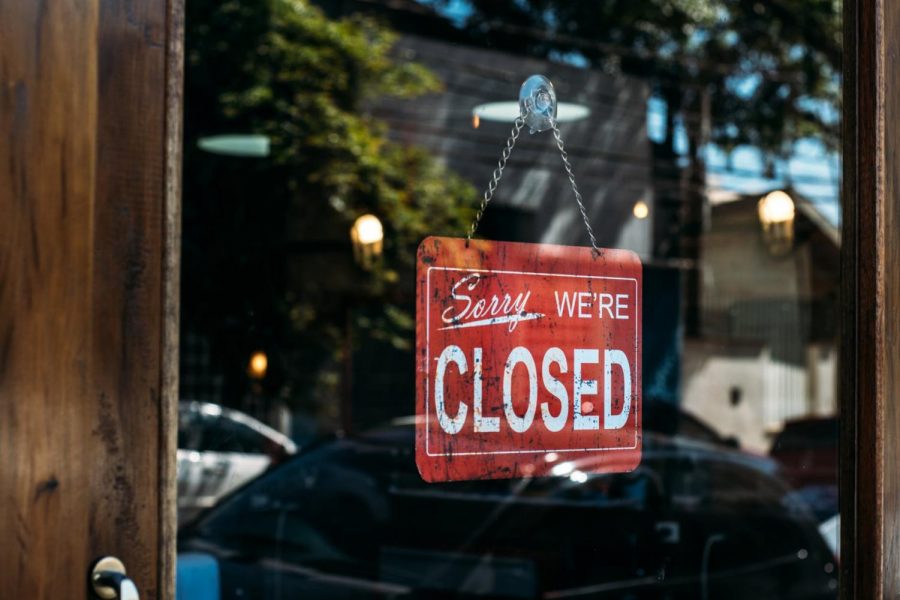Reopening States Early is a Risk Due to the Spread of COVID-19
Opinion
Kaique Rocha
A sign hangs from a shop window, notifying customers that it is closed. Due to COVID-19, many governors had issued stay-at-home orders and shut down non-essential businesses. However, many states are seeking to open early, a dangerous move since the virus is still spreading rapidly and hospitals are ill-equipped to deal with the amount of people infected.
May 16, 2020
The threat of COVID-19 has led many governors to issue stay-at-home orders to enforce quarantine and slow the spread of the virus. Many businesses deemed non-essential, such as retail and entertainment, have shut down. Lately, however, lots of states have planned to slowly reopen with some non-essential businesses beginning in late April and early May, including Texas that opened on Friday, May 1. This is a risky move for many states, considering the lack of testing kits, and the fact that most haven’t gotten past the peak of their infection curves. If these businesses start to open, there could be a serious increase in the amount of people infected, which would be detrimental to the healthcare system.
A lack of testing kits makes it hard to tell who’s infected. We can’t rely on symptoms alone because many of those infected are asymptomatic, where they show no symptoms. If these individuals without symptoms leave the house to go to the businesses that are open, they could risk infecting other people without knowing it.
Without knowing how many of us are sick, we also can’t see if we’ve achieved herd immunity or not. Herd immunity is when most of the population is immune to a certain disease, making it less likely to spread. Knowing the amount of people who have been infected helps us infer the amount of those who have recovered, and are possibly immune to the virus. Without certainty about the number of people who have contracted the disease, reopening states is a huge risk because we won’t know if most of us are immune. The amount of people infected in states is well below the amount needed to be past the highest point of the curve, meaning that most of the population isn’t immune to the novel coronavirus. Being past the peak of the curve indicates that a majority of people have been infected, and could be immune to the virus, possibly reaching herd immunity. However, since so many aren’t immune to the virus yet, reopening states would cause the virus to spread to more people, rapidly increasing the number of infections. The government should obtain more testing kits to better understand the situation before reopening.
The reason we’re staying at home is to flatten the curve, slowing down the rate at which people get infected. Theoretically, the amount of people that get infected is the same whether we quarantine or not, but what changes is the burden on our healthcare system. A steeper curve indicates a faster rise in the number of infections, which leads to reaching the peak in a shorter amount of time. With a more rapid rise in infections, hospitals would have to take care of more patients at a time. Additionally, with the lack of resources, such as ventilators, masks, and ICU beds, healthcare professionals may need to make tough decisions towards how some patients will be treated. Doctors would need to make choices based on who has a higher stake in society, such as essential workers who would need to go back to work as soon as possible, and who is more likely to survive the infection if treated. This would be a difficult and painful decision for doctors to make. As a result of a steep rise in infections, many will die from inadequate care. By slowing the rate of infection, we’re giving hospitals less patients to treat at a time, making resources more available to patients.
The effect of nonessential businesses being closed and their impact on the economy is a pressure leading governors to wanting to open states up at this time. The closure led many people to lose their jobs. Without people working, the economy is negatively affected because of less economic output and a lower gross domestic product. As a result of unemployment, some people are also unable to feed their families. Lots of unemployed people are getting government assistance in stimulus checks and unemployment assistance, but that may not always be enough. Many people will purchase less products since they won’t have the money for it, lowering economic activity further.
However, opening up the country around this time isn’t the answer. If people go back to work soon, many more employees would fall sick, making them unable to work and perpetuating the negative economic cycle. Moreover, they would be exposed to higher levels of the virus, leading to a more severe infection or even death. Human lives are much more important than the economy.
Though restrictions have become relaxed, continue your life like they haven’t. Treat the situation as though the stay-at-home order is still in effect. We should stay at home until the number of infections start to continually decrease before reopening in stages and considering going out. Schools should remain closed, and people should work from home if possible, until we are past the peak. According to the National Public Radio (NPR), states should be having only one new infection per million before reopening, which many haven’t achieved yet. In spite of governors thinking we need to reopen, we need to stay safe, so we should all stay home to prevent the spread of infections.



